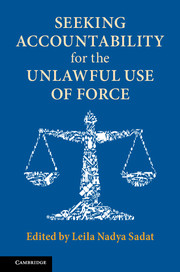Book contents
- Frontmatter
- Dedication
- Contents
- Notes on Contributors
- Foreword
- Preface
- Table of Cases
- Introduction
- PART I HISTORIC AND CONTEMPORARY PERSPECTIVES ON THE UNLAWFUL USE OF FORCE
- PART II MECHANISMS FOR RESTRAINING THE UNLAWFUL USE OF FORCE AND ENHANCING ACCOUNTABILITY
- PART III THE ILLEGAL USE OF FORCE AND THE PROSECUTION OF INTERNATIONAL CRIMES
- 12 The Crime of Aggression under Customary International Law
- 13 The Crime of Aggression and the International Criminal Court
- 14 Prosecuting Aggression Through Other Universal Core Crimes at the International Criminal Court
- 15 The Illegal Use of Force (Other Inhumane Act) as a Crime Against Humanity: An Assessment of the Case for a New Crime at the International Criminal Court
- 16 Aggression, Atrocities, and Accountability: Building a Case in Iraq
- PART IV IMAGINING A BETTER WORLD
- Epilogue
- Index
13 - The Crime of Aggression and the International Criminal Court
from PART III - THE ILLEGAL USE OF FORCE AND THE PROSECUTION OF INTERNATIONAL CRIMES
Published online by Cambridge University Press: 21 May 2018
- Frontmatter
- Dedication
- Contents
- Notes on Contributors
- Foreword
- Preface
- Table of Cases
- Introduction
- PART I HISTORIC AND CONTEMPORARY PERSPECTIVES ON THE UNLAWFUL USE OF FORCE
- PART II MECHANISMS FOR RESTRAINING THE UNLAWFUL USE OF FORCE AND ENHANCING ACCOUNTABILITY
- PART III THE ILLEGAL USE OF FORCE AND THE PROSECUTION OF INTERNATIONAL CRIMES
- 12 The Crime of Aggression under Customary International Law
- 13 The Crime of Aggression and the International Criminal Court
- 14 Prosecuting Aggression Through Other Universal Core Crimes at the International Criminal Court
- 15 The Illegal Use of Force (Other Inhumane Act) as a Crime Against Humanity: An Assessment of the Case for a New Crime at the International Criminal Court
- 16 Aggression, Atrocities, and Accountability: Building a Case in Iraq
- PART IV IMAGINING A BETTER WORLD
- Epilogue
- Index
Summary
INTRODUCTION
At the Review Conference on the International Criminal Court's Rome Statute, held in Kampala, Uganda, from May 31 to June 11, 2010 (Review Conference), States Parties to the Rome Statute1 achieved a significant and historic result. They adopted, by consensus, a definition of the crime of aggression and conditions for the exercise of its jurisdiction for purposes of the International Criminal Court (ICC).2 Not all States were completely satisfied with the outcome – some desiring a stronger jurisdictional regime, others desiring only Security Council referrals, and others disagreeing with the amendment process.3 Further disagreements surfaced after the Kampala negotiations as to the crime's jurisdictional reach. Nonetheless, States Parties have now seemingly resolved these disagreements, and have taken the second historic step, to activate the crime's jurisdiction effective July 17, 2018. The commencement of jurisdiction has potential to change State practice with regard to uses of force, as well as the development of international criminal law.
This Chapter provides a brief overview of the negotiations leading up to the Review Conference.4 It then discusses key features5 of the amendment package adopted in Kampala, including the definition of the crime, the conditions for the ICC's exercise of jurisdiction over the crime, the elements of the crime, and certain understandings. It also discusses the crime's jurisdictional reach – both the competing views that existed, as well as the result apparently concluded in the activation decision at the December 4–14, 2017, meetings of the ICC's Assembly of States Parties (ASP). The Chapter finishes with suggestions of how commencement of the exercise of ICC crime of aggression jurisdiction could impact state decisions regarding uses of force as well as the ICC's docket.
OVERVIEW OF THE NEGOTIATIONS OF THE CRIME OF AGGRESSION
The concept of aggression as a crime is hardly new. The international community envisioned a world in which States would arbitrate their disputes without recourse to war when, in 1899, they founded the Permanent Court of Arbitration (PCA), and, in 1913, opened the Peace Palace in The Hague (Vredespaleis) to house it.6 This vision failed with the advent of both World Wars I and II.
- Type
- Chapter
- Information
- Seeking Accountability for the Unlawful Use of Force , pp. 303 - 336Publisher: Cambridge University PressPrint publication year: 2018
- 4
- Cited by

